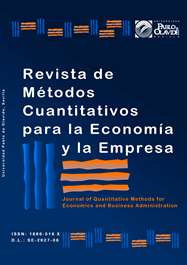Distributive conflict and income's policy around the real exchange rate in a semi industrialized agro-exporter economy
DOI:
https://doi.org/10.46661/revmetodoscuanteconempresa.3478Keywords:
distributive conflict, real exchange rate, unbalanced growthAbstract
A conflict of Ricardian type is arised. Landowners produce exportable salary-goods and consume imported luxury goods. Small industrialists produce non-tradable manufactures with sunk costs by importing capital goods. Employees consume exportable goods and non-tradable manufactures.
Quantities are measured in physical units and prices in fiat money. The international currency is fiduciary. There is no equilibrium of pure economy. Price equilibrium does not imply full employment.
According to the political management, an increase (reduction) in the real exchange rate benefits (harms) exporters, reduces (increases) the real salary and has oscillating effects on industrial benefits, generating oscillating alliances of the industrialists, with eather landowners or workers, in order to achive a favorable real change rate in a zero sum game. Stabilization with the monetary approach to the balance of payments is impossible.
The theoretical model formalizes the structural crisis of peripheral economies that finance technologically dependent industries with agricultural exports.
Downloads
References
Braun, O., & Leonard J. (1981). Un modelo de estancamiento económico. Estudio de caso sobre la economía argentina, Desarrollo Económico. Revista de Ciencias Sociales, 80(20), 585-604.
Díaz Alejandro, C.F. (1965). Exchange-rate devaluation in a semi-industrialized country: the experience of Argentina 1955 – 1961, The M.I.T. Press.
Díaz Alejandro, C.F. (1975). Ensayos sobre la historia económica argentina. Buenos Aires: Amorrortu Editores.
Dornbusch, R. (1976). Expectations and Exchange Rate Dynamics. Journal of Political Economy, 84(6), 1161-1176.
Dornbusch, R., Fischer, S., & Startz, R. (2002). Macroeconomía, 8ª Ed. Madrid: Mc Graw Hill.
Firmenich, M.E. (2015). Teoría de los sistemas político - económicos, EDUCO, Neuquén.
Frits, J. de Jong (1967). Dimensional analysis for economists. Amsterdam: North – Holland Publishing Company.
Guerberoff, S. (1977). Un análisis de la performance del segmento industrial estable y su impacto en el modelo de crecimiento argentino (1949-1967). Desarrollo Económico. Revista de Ciencias Sociales, 64(16), IDES, enero-marzo.
Henderson, J.M., & Quandt, R.E. (1991). Teoría microeconómica - Edición revisada y puesta al día. Barcelona: Ariel Economíax.
Musgrave, R.A., & Musgrave, P.B. (1992). Hacienda pública teórica y aplicada – Quinta edición. Madrid: McGraw Hill.
Olivera, J.H. (1960). La Teoría no Monetaria de la Inflación. El Trimestre Económico, (octubre - diciembre), 616 - 628.
Olivera, J.H. (1968). El Dinero Pasivo. El Trimestre Económico, vol. 35, Nº 140(4) (octubre – diciembre), 695 - 706.
Olivera, J.H. (1984). Sur l'inflexibilité des prix a la baise. Revue d'Economie Politique, 6.
Olivera, J.H. (1986). El Patrón monetario. En: Banco Central de la República Argentina, El Banco Central en su 50° aniversario: 1935-1985.
Pasinetti, L.L. (1985). Cambio estructural y crecimiento económico. Madrid: Ed. Pirámide.
Porto, A. (1975). Un modelo simple sobre el comportamiento macroeconómico argentino en el corto plazo. Desarrollo Económico. Revista de Ciencias Sociales, 59 (15), IDES
Segura, J. (1993). Teoría de le Economía Industrial. Madrid: Editorial Civitas.
Sen, A.K. (1976). Elección colectiva y bienestar social. Madrid: Alianza Universidad.
Sraffa, P. (1983). Producción de Mercancías por Medio de Mercancías. Barcelona: Oikos-tau.
Downloads
Published
How to Cite
Issue
Section
License
Copyright (c) 2019 Journal of Quantitative Methods for Economics and Business Administration

This work is licensed under a Creative Commons Attribution-ShareAlike 4.0 International License.
Submission of manuscripts implies that the work described has not been published before (except in the form of an abstract or as part of thesis), that it is not under consideration for publication elsewhere and that, in case of acceptance, the authors agree to automatic transfer of the copyright to the Journal for its publication and dissemination. Authors retain the authors' right to use and share the article according to a personal or instutional use or scholarly sharing purposes; in addition, they retain patent, trademark and other intellectual property rights (including research data).
All the articles are published in the Journal under the Creative Commons license CC-BY-SA (Attribution-ShareAlike). It is allowed a commercial use of the work (always including the author attribution) and other derivative works, which must be released under the same license as the original work.
Up to Volume 21, this Journal has been licensing the articles under the Creative Commons license CC-BY-SA 3.0 ES. Starting from Volume 22, the Creative Commons license CC-BY-SA 4.0 is used.










